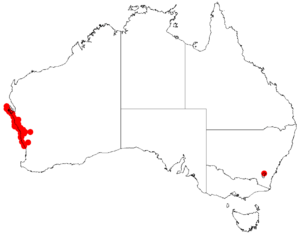Acacia idiomorpha facts for kids
Acacia idiomorpha is a special kind of shrub that belongs to the Acacia family. It's found only in a small part of western Australia. This plant is sometimes called a wattle.
Quick facts for kids Acacia idiomorpha |
|
|---|---|
| Scientific classification | |
| Genus: |
Acacia
|
| Species: |
idiomorpha
|
 |
|
| Occurrence data from AVH | |
What it Looks Like
This Acacia is a spreading shrub that often has small spines. It usually grows to be about 0.2 to 1.0 metre (0.7 to 3.3 ft) tall. Its branches can be covered in soft hairs or be smooth (which means glabrous).
Stems and Leaves
The plant has small, straight, or slightly curved parts called stipules, which are 2 to 7 mm (0.079 to 0.276 in) long. Like many Acacia plants, it doesn't have true leaves. Instead, it has phyllodes. These phyllodes are flattened leaf stems that look and act like leaves.
The phyllodes of Acacia idiomorpha are wavy and have a sharp point. They can be shaped like an egg (ovate) or be more oval or narrow. They are usually 5 to 25 mm (0.20 to 0.98 in) long and 3 to 14 mm (0.12 to 0.55 in) wide. Each phyllode has one main vein that stands out.
Flowers and Seeds
This shrub produces bright yellow flowers. You can usually see them blooming from July to August. The flowers grow in small, round or slightly oval clusters. Each cluster can have anywhere from 40 to 100 golden flowers. These flower-heads are about 5 to 8 mm (0.20 to 0.31 in) across. They grow either alone or in pairs where the phyllodes meet the stem (this spot is called the axil).
After the flowers bloom, the plant forms seed pods. These pods are narrow and often curved. They can grow up to 6 cm (2.4 in) long and are about 4 to 5 mm (0.16 to 0.20 in) wide. The pods are wavy and covered in fine hairs. Inside the pods, the seeds are light grey to brown and often look speckled. They are about 3 mm (0.12 in) long and have a small, fleshy part called an aril at one end.
Where it Grows
Acacia idiomorpha is a plant that is endemic to a specific area. This means it only grows naturally in one small part of the world. For this plant, that area is along the west coast of Western Australia.
Habitat
You can find this plant in the Wheatbelt and Mid West regions. It likes to grow on cliffs and sand dunes close to the coast. It prefers sandy or loamy soils. Often, these soils are found over or around limestone or sandstone rocks.
Range
The area where Acacia idiomorpha grows stretches along the coast. It starts around Ledge Point in the south. Then it goes north all the way up to Tamala Station and Dirk Hartog Island in Shark Bay. This plant is often found as part of mallee groves (areas with certain types of eucalyptus trees) or shrubland communities (areas dominated by shrubs).

